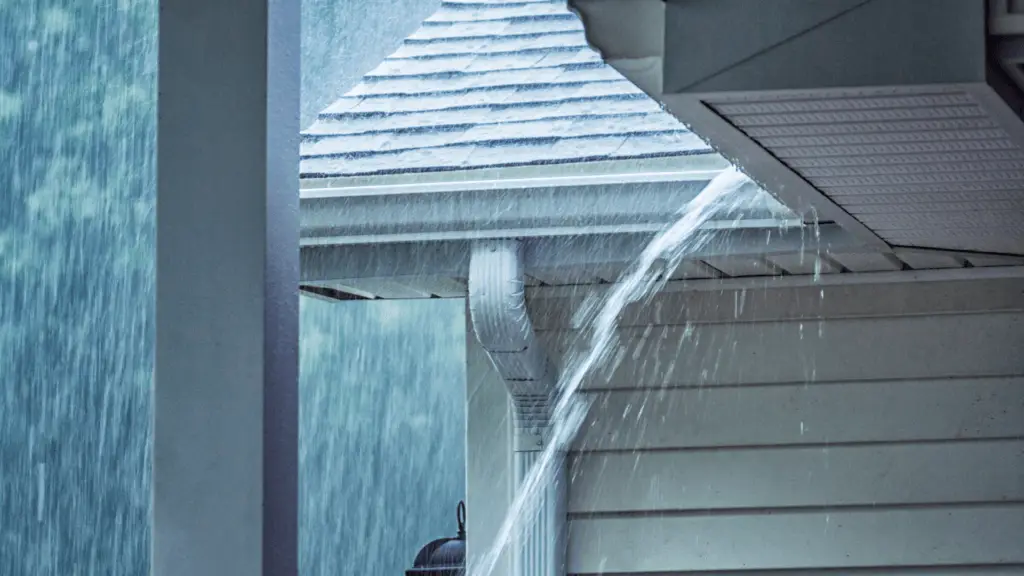As winter slowly warms and signs of Spring begin to show, we also know that storm season is brewing. After all, “April showers bring May flowers.” Is your home ready for rain? Let’s look at tips for preventing water issues during storm season and how to keep your basement and crawlspace dry.
Evaluating Outside Your Home is the First Step to Preventing Water Issues During Storm Season
The annual precipitation for the southeast region of the US is 40 to 50 inches of rain per year. A vast majority of that happens in storm season. Clean gutters, downspouts, and proper landscape grading are essential for preventing water issues during storm season.
Clean Gutters
All those pretty fall leaves have long since fallen and begun to decay. Chances are they may be clogging your gutters and downspouts. Gutters are the first line of defense during storm season because they divert water off your roof and away from your home. If they are clogged, the water flow can be slowed or blocked entirely giving extra weight to your gutters. Damage can happen and the water then pools around the foundation of your home.
A note on gutter guards: Gutter guards are great at keeping large debris from clogging your gutters. Over time, dirt, loose shingle granules, and small decayed leaf matter can still get through. Larger leaves, sticks, and other tree debris can settle over the guards also. Be sure to look over your gutters even if you have gutter guards in place to make sure water flows as it should.
Clean and Functioning Downspouts
In the same way, the downspouts can also become clogged or fall off altogether. Downspouts are essential for directing the water from your roof away from your home’s foundation. When they are clogged, broken, or missing the water pools around the outside of your home and can seep into the ground around your foundation. This excess water can put pressure on your basement walls or seep into your crawlspace.
Make sure your gutters are clear and free-flowing. Make sure your downspouts are functioning and pointed away from your home. These are the first steps for preventing water issues during storm season.
Landscape Grading and Puddling
If the gutters and downspouts divert the water away from your home properly, the next step is proper landscape grading. Where does the water flow once it leaves the downspout? Water will follow the path of least resistance so if the ground around your home points inward towards the foundation water will settle there. This can lead to extensive damage over time. The water will degrade the foundation and/or put pressure on your basement walls eventually seeping in and causing basement leaks. In crawlspaces, the water can settle and cause many problems through condensation such as wood rot, pest infestation, poor air quality, and plumbing and electrical problems.
Make sure the landscape grading slopes away from your home leading water to settle farther or towards a storm sewer. In some cases, landscape drainage must be implemented to properly divert the water.
Puddling Around Your Home
It is normal after a strong thunderstorm or periods of heavy rainfall to see puddles of water around your home. However, if these puddles are still visible after 24 hours with no more rain, you may have water drainage issues. Take note of where the puddling is and how long it is present after a strong storm.
Examine Inside Your Home to Stop Water Issues During Storm Season
Once you have taken steps to properly divert water away from your home, keeping an eye on inside your home is the next step to preventing water issues during storm season.
For Homes With Crawlspaces:
- Look around your crawlspace for puddles of water or signs of dampness. Look for condensation build-up. Look for signs of pest infestation, mold, mildew, or fungus. These are all signs that water has invaded your crawlspace and could be causing damage.
- When walking on the first level of your home listen for squeaky floors, look for condensation build-up on windows, notice doors or windows that stick or won’t stay closed, and take a deep breath to note any foul, damp, or musty smells in your home. (You may need an outsider to give you an accurate smell description- homeowners are often nose blind to scents in their own homes) These are all signs of moisture in your crawlspace and should be evaluated by a professional.
- If you have a dehumidifier in your crawlspace, take a moment to inspect it and make sure it is in good working order.
For Homes with Basements:
- Look around your basement for any signs of staining on the walls, mineral buildup, cracks in the floor or walls, humidity, and obvious signs of water. When caught early, these signs of water damage can be repaired at a much less cost than later down the road.
- Look for condensation or signs of dampness on any things stored in your basement.
- If you have a sump pump, take a moment to make sure it is working properly. For more details on this, check out our blog post 6 Sump Pump Mistakes.
- If you have a dehumidifier in your basement, take a moment to make sure it is in good working order.
Waterproofing Your Home Now Can Prevent Water Issues During Storm Season
Waterproofing your basement or crawlspace now can save you money, time, and stress in the future. The professionals at Aqua-Guard Waterproofing can evaluate your home and look for the ways water could most easily invade, then offer solutions to keep your home dry during storm season. We offer free estimates and a single point of contact throughout the entire process. Once work is completed we offer a “Life of the Structure” guarantee that stays with your home despite future owners. We believe that strongly in our work.
Contact us today to help you get your home ready for rain and to have your water problems solved.









